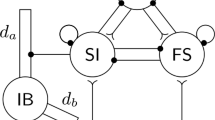Abstract
Autonomic oscillatory activities exist in almost every living thing and most of them are produced by rhythmic activities of the corresponding neural systems (locomotion, respiration, heart beat, etc.). This paper mathematically discusses sustained oscillations generated by mutual inhibition of the neurons which are represented by a continuous-variable model with a kind of fatigue or adaptation effect. If the neural network has no stable stationary state for constant input stimuli, it will generate and sustain some oscillation for any initial state and for any disturbance. Some sufficient conditions for that are given to three types of neural networks: lateral inhibition networks of linearly arrayed neurons, symmetric inhibition networks and cyclic inhibition networks. The result suggests that the adaptation of the neurons plays a very important role for the appearance of the oscillations. Some computer simulations of rhythic activities are also presented for cyclic inhibition networks consisting of a few neurons.
Similar content being viewed by others
References
Barlow RB Jr, Fraioli A (1978) Inhibition in the Limulus lateral eye in situ. Gen Physiol 71:699–720
Friesen WO, Stent GS (1977) Generation of a locomotory rhythm by a neural network with recurrent cyclic inhibition. Biol Cybern 28:27–40
Hadeler KP (1974) On the theory of lateral inhibition. Kybernetik 14:161–165
Harmon LD, Lewis ER (1966) Neural modeling. Physiol Rev 46:513–591
Kling U, Székely G (1968) Simulation of rhythmic nervous activities. I. Function of networks with cyclic inhibitions. Kybernetik 5:89–103
Luciano DS, Vander AJ, Sherman JH (1978) Human functions and structure. McGraw-Hill, London, New York, pp 105–106
Marden M (1966) Geometry of polynomials. American Mathematical Society, Providence, Rhode Island, pp 166–193
Matsuoka K (1984) The dynamic model of binocular rivalry. Biol Cybern 49:201–208
Morishita I, Yajima A (1972) Analysis and simulation of networks of mutually inhibiting neurons. Kybernetik 11:154–165
Nagashino H, Tamura H, Ushita T (1981) Relations between initial conditions and periodic firing modes in reciprocal inhibition neural networks. Trans IECE Jpn J64-A: 378–385 (in Japanese)
Reiss R (1962) A theory and simulation of rhythmic behavior due to reciprocal inhibition in nerve nets. Proc. of the 1962 A.F.I.P.S. Spring Joint Computer Conference. Vol. 21 National Press, pp 171–194
Sugawara K, Harao M, Noguchi S (1983) On the stability of equilibrium states of analogue neural networks. Trans IECE Jpn J 66-A:258–265 (in Japanese)
Suzuki R, Katsuno I, Matano K (1971) Dynamics of “Neuron Ring”. Kybernetik 8:39–45
Wall C III, Kozak WM, Sanderson AC (1979) Entrainment of oscillatory neural activity in the cat's lateral nucleus. Biol Cybern 33:63–75
Author information
Authors and Affiliations
Rights and permissions
About this article
Cite this article
Matsuoka, K. Sustained oscillations generated by mutually inhibiting neurons with adaptation. Biol. Cybern. 52, 367–376 (1985). https://doi.org/10.1007/BF00449593
Received:
Issue Date:
DOI: https://doi.org/10.1007/BF00449593




